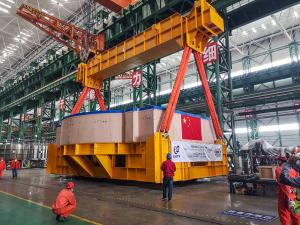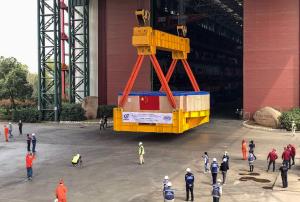Deliveries
A third magnet ready for transport to ITER
23 Mar 2020
-
ITER China
Three ITER magnets are now in transit to ITER from different points on the globe—two toroidal field magnets and one poloidal field coil. In terms of component weight, without counting packaging and transport frames, they represent more than 1,000 tonnes of equipment.
The crated component and transport frame are lifted for removal from the ASIPP facility, where it was six years in the making.
On Sunday 22 March, a 400-tonne ITER magnet—poloidal field coil #6 (PF6)—left the premises of the Institute of Plasma Physics, Chinese Academy of Sciences (ASIPP) in Hefei, China.
The first in the poloidal field magnet series to be installed into the Tokamak Pit at ITER, PF6, is the result of collaboration between the procuring Domestic Agency—Europe's Fusion for Energy—and the ASIPP as principal contractor. After a manufacturing completion ceremony in September 2019, the magnet went through extensive testing before being packaged for transport.
The 400-tonne component will travel by barge on the Yangtze River to Shanghai, and then by ocean transport to Fos-sur-Mer harbor in France.
When it arrives at ITER along the dedicated road itinerary, which had to be adapted to its imposing dimensions, it will be delivered to Europe's on-site winding facility, where Fusion for Energy teams will perform final acceptance tests, as well as further electrical, leak and cold tests.
Only then will the component be ready for handling and transport to the Cleaning Facility and finally the Assembly Hall, where overhead cranes will take charge of the load for delivery to the Tokamak Pit.



